Gundagai
Rainfall Analysis
The main rainfall observing site used in this analysis was Mt Horeb - Marathon (Bureau of Meteorology Station No. 072154), which is 17 km from Gundagai and has records beginning in 1926. Rainfall observations at Gundagai (No. 070069) began in 1893; the station closed in 1971. There is a high degree of correlation between the two sites, which allowed the creation of a continuous time series from 1893 to the present (see Appendix 2 for further information).
Note that in the following analyses rainfall totals for individual months or years (where the year is defined as the 12 months from July to June) are compared to the long-term average (or climatology) from 1961-1990. A 30-year period is used to calculate climatological averages to conform with World Meteorological Organisation practice; this takes into account year-to-year variations and less frequent events such as El Niño or La Niña. This particular 30-year period is used internationally as a standard climatological average period.
As shown in the table below, Mt Horeb was drier than average in all four years in the period 2004/05-2007/08. The driest year was 2006/07, when rainfall was 46% below the long-term average at 403 mm for the year. This was the fourth driest Jul-Jun 12 month period since the record at Mt Horeb began in 1893, and the driest year in the last 75 years. The wettest year in the last four years was 2004/05, when rainfall was 9% below average.
| Rainfall Statistics | Gundagai (Mt Horeb) | |||
|---|---|---|---|---|
| Annual Total* (mm) | 2004/5 | 2005/6 | 2006/7 | 2007/8 |
| Anomaly (mm) | -69.9 | -133.7 | -337.5 | -139.7 |
| Anomaly (%) | -9.4 | -18.1 | -45.6 | -18.9 |
| Mean (1961-1990) (mm) | 740.5 | |||
*Note: annual totals were calculated for the 12 months July-June.
Monthly Rainfall, 2004-2008
A comparison of monthly rainfall totals with the long-term monthly average rainfall at Mt Horeb (Figure 1) shows that most of the period experienced below-average rainfall interspersed with short periods of average or above average rainfall. The dry conditions during 2006/07 reflect the impact of the El Niño event during this period, while the increase in rainfall at the end of 2007 is associated with the development of a La Niña event.
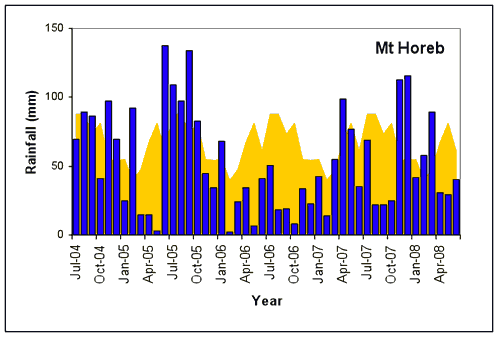 |
Of the 48 months in this period, 28 months (58% of the record) had below-average rainfall at Mt Horeb (Figure 2). There was a prolonged period of below-average rainfall between November 2005 to February 2007 with shorter periods of dry conditions during autumn 2005, June to October 2007 and April to June 2008. The driest month for the period was February 2006 with 2 mm (long term average for February is 39.8 mm), whilst May 2005 recorded 2.6 mm. Rainfall was above average during the periods June-October 2005 and November 2007 to March 2008. The wettest month was June 2005 with 137.8 mm (long term average for June is 60.7 mm). This was in the top 10% of wet Junes in the record at this station.
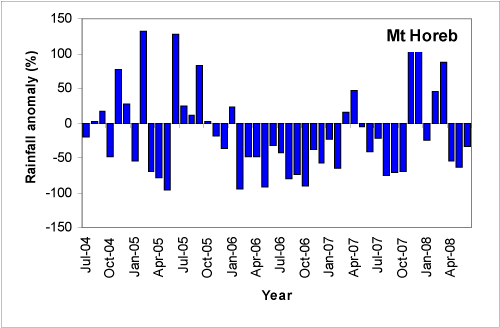 |
The result of the generally dry conditions at Mt Horeb during 2006/07 is reflected in the deficit of accumulated rainfall anomalies (Figure 3). While the accumulated monthly rainfall totals were close to average until January 2006, there was a rapid increase in the accumulated deficit during 2006 which continued through 2007, before rainfall accumulation stabilised in 2008. The increased deficit on 2006/07 reflects the dry conditions due to the impact of the El Niño event during this period. The accumulated deficit for the four-year period was 601.9 mm (77% of the Jul-Jun average rainfall).
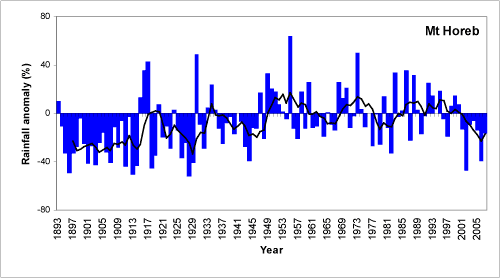 |
The climatological context for rainfall at Mt Horeb (Gundagai)
The long-term perspective
As is typical of the region, Mt Horeb has experienced large fluctuations in annual (July-June) rainfall, including several extended periods of above- or below-average rainfall since records began in 1892. In general, annual rainfall was lower and less variable early in the 20th century, followed by a period of greater variability. Rainfall variability has been moderate since about 1980 (Figure 4). The recent dry period has counterparts in other parts of the long term record such as the early part of the 20th century and the period from the late 1920s to the mid 1940s. To date the recent dry conditions appear to fall within the range of long term rainfall variability in the region.
- Rainfall in the late 19th and early 20th century was generally below average (to about 1950), with the notable exception of a short wet period in the 1910s. Since then annual rainfall totals have been more variable.
- Several wetter-than-normal years around 1950 and 1960 produced a generally wetter period then.
- A generally drier period around 1980 was followed by some wetter years during the 1980s. Since 1994 conditions have been generally drier than average.
The wettest year (July-June) on record was 1955/56 (1199 mm); the driest year was 1928/29 (381 mm).
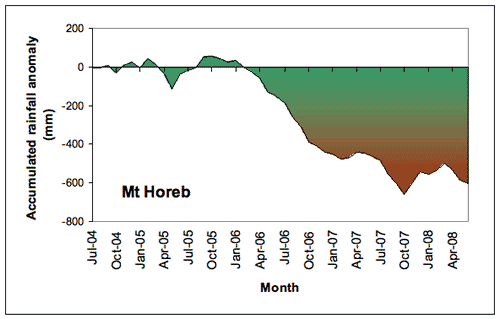 |
The impact on accumulated rainfall since 2000 of two successive El Niño events without a compensating wet period is shown in Figure 5. Accumulation was close to the norm until 2002, when rainfall accumulation went into deficit compared to the long-term average. The deficit then flattened throughout 2004/05 before rapidly dropping again during 2006/07. During this eight-year period there were 58 months (60%) of rainfall deficit. The total accumulated deficit over this period is 998.6 mm (127% of Jul-Jun average).
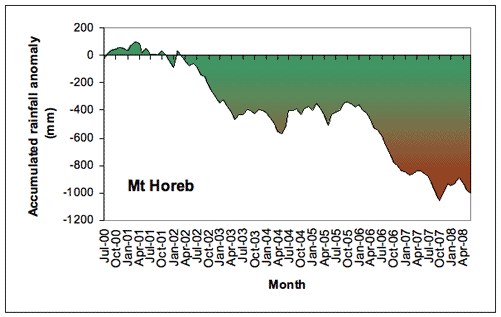 |
About the data
